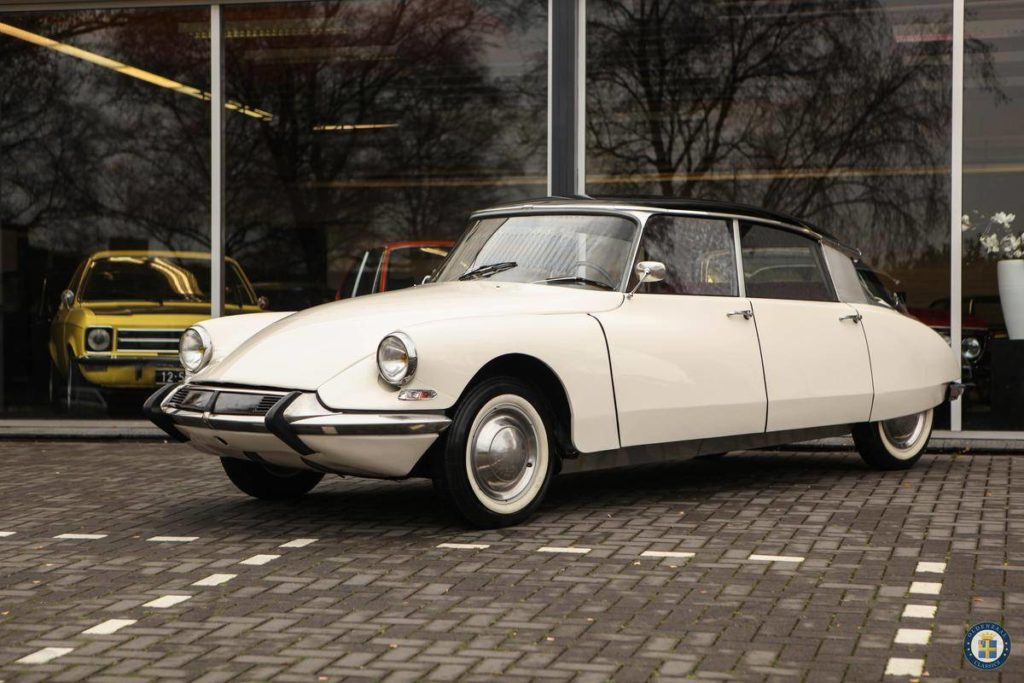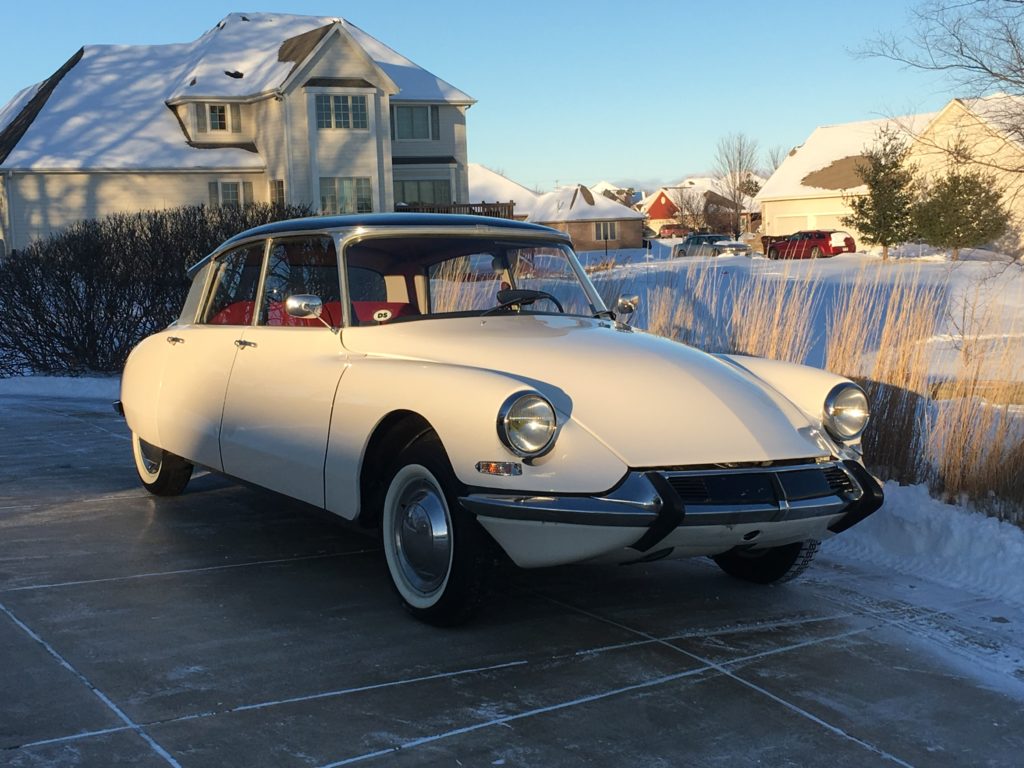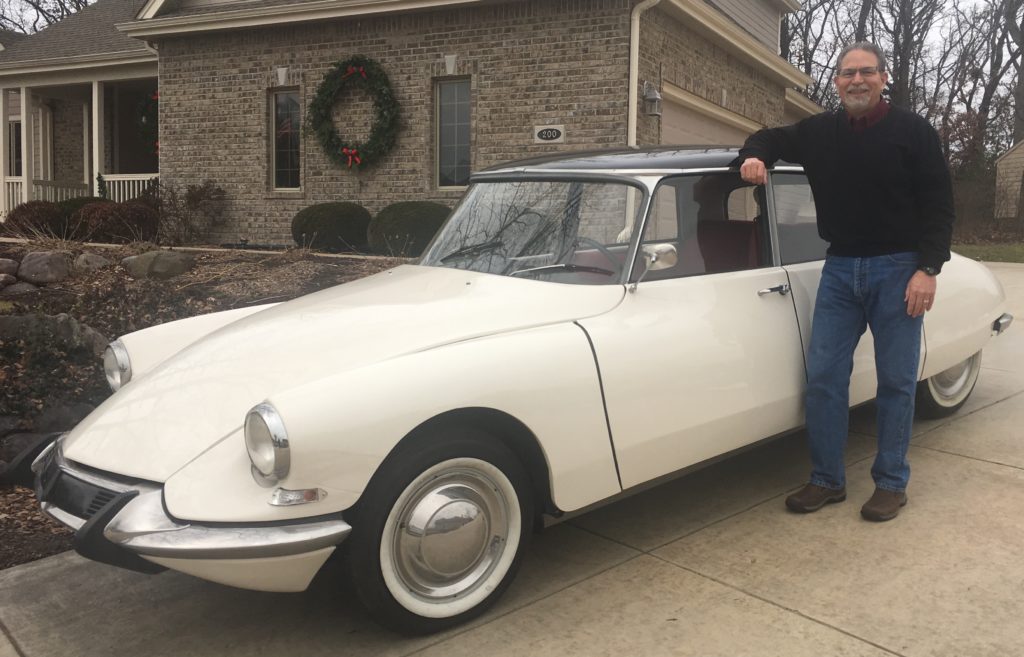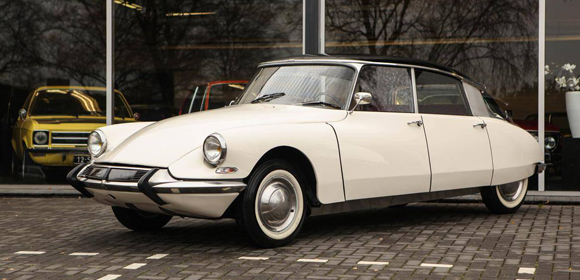By David Bernstein…..
In 2018, after retiring from work, I purchased a classic car of my dreams, a 1965 Citroën ID from a dealer in the Netherlands. Having never done anything remotely like this before, nor having read about anyone doing such a thing (although many, many people have), I wanted to document the process so that others might learn the ins and outs of making such a transaction. I don’t claim to be an expert by any means, and the experiences of others may be quite different – maybe even a lot better. With that said, here is my story.
FIRST ENCOUNTER
It must have been the late 1950’s when our parents took us to visit their friends, Wally and Sonny in the suburbs of Chicago. Sonny was her nickname – her real name was Sonia, and she spoke with an accent that as a young boy I’d never heard before. She was French, and Wally had brought her back to the United States to be his wife after World War II.
As the parents enjoyed cocktails and cigarettes while catching up in the living room and listening to Percy Faith and Henry Mancini albums playing on Wally’s hi-fi, my brother and I were in their kids’ bedroom playing with toy cars. It was there that I encountered the strangest looking car I’d ever seen – a Citroën DS. It looked nothing like the other cars we played with, and we saw that its steering wheel had only one spoke. Strange, indeed.
Fast forward about 55 years, and somehow the Citroën DS memories came back to me as I neared my planned retirement. Out of curiosity, I started doing internet searches to find out more about them and even started thinking about maybe buying one as a retirement gift to myself. Admittedly, I am not what anyone would consider to be a “gear head” or even “mechanically inclined.” This is a distinct disadvantage when considering the purchase of a classic vehicle that never really caught on in this country. But with each successive internet search, the Citroën DS intrigue grew stronger.
NARROWING IT DOWN
After educating myself about the DS – the different front ends, the different models, etc. – I settled on what I believed would be the perfect configuration for me: A 1967 DS, which would have the newer LHM hydraulics but still retain the classic dashboard, steering wheel and nose. And, I wanted the Citromatic transmission to get the full experience. Oh, by the way, it also had to be immediately road-worthy and within my budget. No problem!
It didn’t take long to realize that I wasn’t the only one who found this to be a desirable year. I scanned many different sites – Hemmings Motor News, Classic Trader, Classic Cars, Classic Driver, etc. and looked at dozens if not hundreds of DS’s offered for sale by dealers and private sellers from all around the world. Finding THE ONE was a lot more difficult than I thought it would be, even though there were several that I was interested in at one time or another. Many of those were sold quickly before I could muster up the courage to actually get into the game.
There was one, however, that I really liked from the time I first saw it advertised by Oldenzaal Classics (www.oldenzaal-classics.nl) on the Hemmings Motor News site back in late 2017. Unfortunately, it wasn’t exactly what I’d set up as my parameters. It was a 1965 ID, which still had the LHS-2 hydraulics, and a manual transmission. It was also at a dealer in the Netherlands, and priced just out of my budget range. I didn’t pursue it.

Months passed, and I found dozens of other DS’s for sale from Poland to California and everywhere in between. Again, a few of them were interesting, but not exactly what I was looking for. In the late Spring of 2018, I started seeing the ad for the same 1965 ID I’d seen in 2017. But now, they’d dropped the asking price significantly. I emailed them with some questions, and I was surprised to receive a phone call from a man at the dealership in the Netherlands, and he spoke perfect English.
PRE-PURCHASE INSPECTION
We continued to correspond by email and, occasionally, by phone over the course of the summer. I’d never made such a large purchase “sight unseen” before. All I really had to go on was the dealer’s photos and description of the car. I asked the dealer about a pre-purchase inspection, and he told me they are done all the time by foreign buyers. He gave me a recommendation for a Citroën expert, Salco Hoogeweij (www.kfz-oltimer-sachverstaendiger.de) who could perform the inspection for me. Admittedly, I was a little uncomfortable with this because he was the same person who performed the valuation appraisal of the car for the dealer. I learned that every classic car needs to have a market value so the dealer knows how much to insure it for while they own it.
Having been unsuccessful in trying to find anyone else to do a pre-purchase inspection overseas, I had Salco do the inspection for 150 Euro, or about $181 US. He uses PayPal to receive payment. On July 26, I received a 6-page report from him via email that covered the engine, fuel system, drive train, brake system, suspension, exhaust, hydraulic system, safety, body and chassis, run and road test, and VIN Title verification. He did find a very few minor issues that I required the dealer to fix as part of my offer to purchase.
NEGOTIATING A PRICE
As I mentioned earlier, the dealer had dropped the asking price significantly – about $7,000 – since I’d first seen the car advertised several months earlier. This showed me that they were anxious to get it sold. I wasn’t familiar with the proper negotiating protocol when dealing with a classic automobile in a foreign country, so I did what I do at home when buying a new car: I made a fairly low offer (about 12% below their new asking price) and waited for them to respond.
I’ve found that one key to any negotiation is to be ready to walk away if you can’t get close to what you want. And, I was ready to do just that if I couldn’t buy the car close to where my price was. I was pleasantly surprised when they counter-offered at just $700 over my offer. But that wasn’t quite good enough for me, and we finally ended up splitting the difference. I bought the car for 10.4% less than their asking price.
Another key to negotiating is timing. Not only had the car been sitting at the dealer for a long time, my offer came at an advantageous time in the relative strength of the dollar vs. the euro. Because we were negotiating in US dollars instead of Euros, the dealer told me he couldn’t have made the same deal two weeks earlier… but who knows?
WIRING MONEY OVERSEAS
Now that we had agreed on a price, how would the dealer get paid? I was told that I’d have to wire the money from my bank account to the dealer’s bank in the Netherlands. This made me a little uncomfortable, to send a substantial amount of money to purchase a car I’d never seen from people I didn’t know, with no assurance that I’d ever actually get what I was paying for. I talked to the dealer on the phone about this, and he assured me that 1) the dealership had been in business for a long time, 2) my car was one of the least expensive cars on their lot, and 3) their reputation and business would be ruined if they weren’t above-board with their dealings. Also, this was the only way I could get the car!
So, on August 18, after months of back and forth, down to my local bank I went, armed with all the wiring information provided to me by the dealer. In a way it was a leap of faith – but then again, that’s pretty much what this whole experience has been. The folks at the bank were happy to help me, and made the transaction without a hitch. By the way, the fee for an overseas wire transfer was $45.
A copy of the Bill of Sale was emailed to me for my signature and return to the dealer. One other thing I had to provide to the dealer was a copy of my Driver’s License so that the car’s Dutch title could be transferred to me.
SHIPMENT FROM EUROPE
Once the payment was in the dealer’s account, the dealer started to make arrangements with their transport company, Global Transport Amsterdam. After I’d spent all that money, I was anxious to get my car home so I could enjoy it before winter set in.
The car was to be shipped from Amsterdam on September 5, with arrival in Baltimore expected on September 27. Unfortunately, the voyage of the ship that my car was first booked on was cancelled, and re-routed to the Far East instead of the USA. The next ship they tried to book my car on was held up in the USA due to Hurricane Florence. Finally, they arranged transport on a third vessel, which sailed out of Zeebruge, Belgium on October 1, nearly an entire month later than I originally expected. I was supposed to be sent an invoice for 1,117 Euro once the ship left. This excluded all-risk insurance, which was 0.9% of the value of the car, with a 500 Euro deductible. I didn’t receive an invoice until October 18, after the car was already in Baltimore. In all, on October 24, I wired $1,641 to Global Transport.
CLEARING CUSTOMS
On October 5, while the car was en route to the USA, I was contacted via email from the US transportation company, Horizon Auto Shipping, Inc. in Houston, which would process the customs documents and deliver my car to my home. In addition to needing my Social Security number and a copy of my Passport, they also sent me the following forms to complete, sign, and return to them: 1) Customs Power of Attorney, 2) EPA Declaration Form, and 3) Dept. of Transportation Declaration Form for Safety, Bumper, and Theft Prevention Standards. I also had to provide them with copies of the foreign vehicle registration and bill of sale.
Of course, I completed and returned all the paperwork at once via email. On October 15, I received an urgent message that they needed the paperwork ASAP! Apparently, they never received my original email so I immediately sent it all again.
The final hurdle for my car to clear customs was the payment of the Customs entry service, port wharfage & terminal charges ($350), U.S. Customs Duty & Taxes ($664), Customs Bond ($115), and delivery charge from Baltimore to Wisconsin ($850), a total of $1,979. These charges were itemized on an invoice from Horizon Auto Shipping. This I was able to pay via credit card online.
Finally, early in the morning on November 1, my car arrived at my home!


STATE TITLE AND COLLECTOR PLATES
About the time my car shipped from Europe, I started to obtain and fill out the necessary paperwork to get a Wisconsin title and Collector Plates. All the forms were available online. In addition to the two application forms (Title and Collector Plates), I needed to send in the original Dutch Title and copies of all the shipping paperwork.
In Wisconsin, Collector Plates are a one-time fee of $200 (with no annual renewal fee); a new Title fee is $69.50; and, State Sales Tax is 5.1% in my county. In all, I sent a check for $1,409 to the State of Wisconsin, and in about six weeks a pair of shiny new light blue with red letters Collector Plates arrived, along with a new Title. My new car was officially mine and legal to be driven!
INSURANCE
I’d seen advertisements for Hagerty Insurance, which specializes in classic cars. I called my local insurance broker to discuss insuring it, and they recommended Hagerty as well vs. the company that I have my other vehicles insured through. I was pleasantly surprised that my annual premiums are only $278 for full coverage.
OWNING IT!
One of the first things I did was have seat belts installed by a local auto interior shop so that my passengers (including my grandchildren) and I are safer when we take it out for a spin. They are “retro” (airline) style and match the red interior perfectly.
I bought the car with the intention of driving it often, and fortunately, winter arrived later than normal this year so I was able to put a few hundred miles on it. But I’ve now got it tucked away in my garage for the winter, and look forward to driving it a lot once spring arrives.

COST SUMMARY
Here is a summary of all the costs associated with the sale and delivery of my car, not including the actual purchase price and local sales tax (5.1%), title ($70), and one-time collector license plates ($200).
| Pre-purchase inspection | $ 181 |
| Wire Transfer fee of Sale Price | $ 45 |
| Shipment from Europe to Baltimore | $ 1,440 |
| Shipment Insurance | $ 201 |
| Baltimore Terminal Charges | $ 350 |
| Customs Duty & Taxes | $ 664 |
| Customs Bond | $ 115 |
| Delivery from Baltimore to Wisconsin | $ 850 |
| _______________________________________ | ______ |
| Total Costs | $ 3,620 |


Was your ID shipped RORO (Roll On, Roll off) or in a container? I ask because I am about to ship my DS back from London and I have heard that securing these cars for transit can be tricky. Usually they run straps through the wheels to secure the cars to the deck of the ship. Not really possible with these. The “tow hooks” supposedly tear out part of the undercarriage if used as tie downs and pulled too tightly. I have seen wheel nets proscribed but I wonder how many ships actually have those. Do you know how yours was secured or if the dealer took any special precautions?
My father-in-law shipped a BMW from Amsterdam to the US and somewhere along the way the tie-downs were run over the sway-bar links. Two of the dog-bone links were broken along the way, although nothing else was damaged and the repair was cheap. It’s an issue worth paying attention to, however.
Hagerty published an excellent article about importing cars from overseas to the USA. You can find it here: https://www.hagerty.com/media/advice/5-tips-for-importing-a-collector-car/?. Note that in the comments there is mention on importing cars into the USA from Canada and it is stated that “there is (was?) no import duty on cars moving from Canada to the US (part of NAFTA).” That is not case with a Citroen. You pay 2.85% of the purchase price in duty.